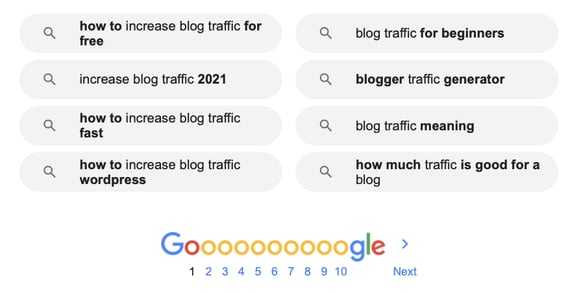9 Proven Strategies to Increase Blog Traffic in 2021

If you’ve included blogs as part of your core content strategy but still don't see it taking off, don’t cut it off just yet. It may just need a bit of tweaking, resuscitation as it were. The way blogs are ranked is ever-changing. Your strategies are only as good as the last algorithm update for search engines. But amazingly, even with the dynamic search engine ranking rules, HubSpot reports that blogs are still part of the top 3 content strategies used today.
With that in mind, here are 9 proven strategies to help your blog get the traffic it deserves. Let's get right to it.
1. Start with SEO
According to BrightEdge, search engine optimization produces 1000% more traffic than organic social media does. If you’ve been utilizing SEO techniques and are using SEO tools, check out which strategies you still haven’t applied yet and start planning on incorporating this into your blog creation process.
Using the right keywords will make a big difference in how search engines will rank your blog. To find the right keywords, you need the right tools:
- SEMrush or Ahrefs (paid tool): use it to check out what keywords your competitors are using. It’ll give you a good idea of what keywords high domain blogs are using so you can use it too.
- KWFinder (paid tool but more affordable): If SEMrush and Ahrefs are heavy on the pockets, you can use this alternative.
- Google Keyword Planner (free tool): this free tool by Google will help you find the related keyword for any seed keyword
Another cost-free way to find related keywords is to Google your seed keyword and check out the related search results at the bottom of the page.

Plug the related keywords on the keyword search tool to check for keyword difficulty. Go for the ones with low difficulty and build your content around that topic. Now that you’ve determined the right keywords, blend them around your content to optimize it for posts for that keyword. In other words, work on your on-page SEO just like how close.com did on their predictive dialer blog.
Here’s a list of things you can do within your post for on-page SEO:
- Add the keyword on your title tag
- Add the keyword on your URL
- Use related keywords or LSI keywords within the H1 (title) and H2 (subheadings)
- Sprinkle related keywords on the paragraphs, a ballpark number would be 10x for a 2000-word article
- Use the keywords in the alt text of the images
Other than utilizing the keywords, here are more things you can do for your on-page SEO:
- Use multimedia that will enhance the reader’s understanding of the point you are making
- Make the page design responsive for desktop and mobile users
- Add social sharing buttons so it’s easier for readers to share your blog with others
- Boost dwell time by creating engaging long-form content
For best results, utilize links. Add internal links to your posts connecting them to other related pages within your website. Also adds external links but be sure to just link to credible websites.
Lastly, build links with other websites. You can do this by creating informative posts that others will likely want to refer to or to do guest posting on related websites. More on that in a bit.
2. Create Irresistible Headlines
You’ve probably heard before that only 80% of people read the headline, and out of it, only 20% move on to read the rest of the article. So here’s the point:
No matter how good your content is, without a compelling headline, it will go unread. You can safely say that the headline is the make-or-break element of your content. And you just have at least 3 seconds to grab the reader’s attention before they scroll off.
So how do you make irresistible headlines? Here are some techniques you can apply:
Make Your Headlines Specific
Your headlines should give the reader what exactly they’re going to get from your post. If your headline goes like this:
“Lose Weight the Easy Way”
It’s a sure way for prospects to scroll off to find a better post to read. But if you write it like how TransparentLabs for their weight loss guide, it’ll be more effective:

People will know what to expect and they are more likely to click on it.
Include a Number
A study from Moz shows that headlines with numbers in them get 327% more clicks than headlines with bland questions. A good example of these are blogs from presetlove.com. They mostly include numbers so it’s easy to know what you get from it.

In fact, this is another way to be specific, so your headline can be more compelling.
Infuse Strong Emotions
Emotional headlines make the best headlines. How do you make your headlines emotionally charged? You can add words like:
- Now
- Fast
- Crazy
- Breakthrough
- New
- Amazing
- Mistake
- Free
- Top
Here are great examples from growthrocks.com when they used the word “top” in the headline and from trackingtime.co when they used the word “free”.

Using these words strikes an emotional chord within the reader compelling them to find out more. But, don’t go overboard, just use one emotionally charged word at a time.
Infuse Strong Emotions
What is WIIFM anyway? It stands for “What’s In It For Me”. People will only care enough to read your blog if it has a personal benefit for them. Right on the headline, they should sense that the blog is all about them. Make the headline all about your target audience and less about you and your brand.
Like what revenueriver.co did with their HubSpot sales hub blog titled: “Launching a HubSpot Enterprise Sales System in Less than 30 Days”.
Use FOMO
Like emotionally charged words, FOMO moves people to action based on what they feel. So what is FOMO? It means Fear Of Missing Out. This is an intrinsic trait of humans, not wanting to be not in the loop, not part of what's happening around, or missing on news. While you don’t have to use it for every headline you make, utilizing it from time to time will spark up the interest of your readers.
How do you do this? You can include the word “limited” or use the phrase “every ____should know about”. Or something like what meetfox.com did when they headlined a post with “5 Must-Have Tools”.
 It’ll make them feel like it’s information they can’t pass on, and this will move them to check it out. Just don’t forget to live up to the expectation and deliver what you promise. Now that you’ve optimized your own blogs, what else can you do? Check out this next strategy.
It’ll make them feel like it’s information they can’t pass on, and this will move them to check it out. Just don’t forget to live up to the expectation and deliver what you promise. Now that you’ve optimized your own blogs, what else can you do? Check out this next strategy.
Strategic Guest Blogging
Guest blogging is a proven way to increase traffic to your own blogs. But there rather than pitching here and there, there’s a strategic way to do it so you can make the most out of the effort you put in it. How? Write guest posts on relevant and high-traffic blogs.
With this strategy, you’ll be hitting two birds with one stone. You don’t only build links back to your blogs so you can rank higher on search engines, you also get more potential readers for your blogs. If the website you’ll be guest posting is related to your website, most likely, the audience that it was able to build will also be interested in the topics you have on your website. Plus when it’s a high-ranking website, you can expect a huge number of readers which means huge potential readers for your blogs too.
Take a look at Moosa Hemani’s stats when he guest posted on Moz.com:

In just one guest post for Moz.com, he’s generated 3,016 visitors in the span of four months. Here’s the 3-step process that he followed that you can copy too:
Step 1: Find blogs with high social influence
Google loves active blogs with lots of social media followers. It tells them many are interested in what they write and so they’re confident in ranking them for others to discover. So before you pitch posting a blog to a website, check out their social channels first. It’ll help you get a good idea of how many people will find your blogs if you write for their website.
Step 2: Research top-ranking sites
A good way to ensure your guest post will rank well is to write it for websites that already rank on top. Just input your long-tail keyword on the search box and see what results come up. The good thing with long-tail keywords is that you’ll have fewer chances of finding other blogs that write the same topic as yours. But you’ll be given a list of nearly related pages for that keyword so you can pitch that topic to those websites.
But there’s a catch: Seeing that they already rank high shows that they already have a pattern of creating quality blogs. Just be sure you can write at their level so they’ll be inclined to accept your guest post pitch.
Step 3: Time to pitch
After finding the right website to pitch your topic to, it’s time to make the pitch. Here’s how you can do it.
For websites that have an open invitation to write guests posts:
- Take note of their requirements and follow their regulations
- Find out the popular topics they have on the site and use them as an inspiration to write your guest post
- Create a compelling headline (like what we talked about earlier in the post)
- Add visual elements like infographics, images (avoid stock photos), statistics, or anything other interesting visuals
- Proofread your guest post to ensure it won’t get rejected
For websites that don’t have an open invitation to guest post:
- Fill up a “contact us” form or send them an email if an email address is provided
- Make the email pitch short and direct and include a few sample articles you’ve written that they can refer to
- Offer to write an outline first to see if it’s a good fit for their blogs
- If after one week they don’t reply, send them a follow-up email
4. Create Viral Content
What makes content viral? Many want to create it but only a few succeed. Where do you start?
A good place to start is by being a storyteller right from the headline. People love stories. Get them hooked to a bit of the story and tease them to read on to the content to find out more. Here’s an example:
“I wasn’t getting too much traffic to my blogs so I tried a new strategy and look what it did for my website”
That’s a teaser right there. You give part of the story but leave the rest to the body. I know, I know. People hate clickbait. But think about this: It’s only bad when you don’t deliver in the end. But if you can give them what they expect from your content, there won’t be a problem using a teaser of that sort.
Now, where do you get ideas for your viral content? One way is to understand your audience so you’ll know what they are interested in. A second thing is to check Answer The Public or forums like Quora and Reddit. Check what people are talking about on those platforms and you’ll have your topic for your viral content. But is it good to just focus on viral content? Not always. Viral can be fleeting, but evergreen content is more sustainable.
This brings us to our next strategy.
5. Create Evergreen List Posts
Evergreen list posts are good for sustained success. It can generate traffic for years. How do you come with topics with evergreen potential? Here’s how:
- Make a specific promise
- Make it useful in addressing the specific promise
Here’s an example:
“49 Blogging Tips To Get Readers To Take Action”
Places to do some sort of hobby can also be great for evergreen list posts like what Gili did with this blog on a list of places to paddleboard.

You can also check the blog by optimalworkshop.com talking about 9 tips on note-taking. Another thing to keep in mind is that titles for evergreen list posts with high odd numbers work great.
6. Restructure Your Posts
Restructuring your post can do a great deal in increasing your blog traffic. Most readers are scanners and skimmers so if they can digest the content easier, they’ll be more likely to finish it and find share-worthy information. You can do this by using more headings, lists, blockquotes, and bullets. Even long-form content will be more digestible and look shorter to read when it is not in the form of a wall of text. Adding more images will help too. It breaks up the text and increases readability. It’s also good to use “you” and “I” more. It makes the content more conversational, casual, and relaxed.
7. Use Email to Generate Traffic
Oberlo reveals that there are 3.7 billion email accounts around the world and 269 billion emails sent every day. This clearly shows email is still widely used. But this doesn’t mean you send an email to each one of these email addresses. Not all of those are active and are interested in your niche. The point: build an elite email list to promote your blogs. You can add an email capture form on your website pages to start building your lists like what orizabaorginal.com did.

Or you can give them a lead magnet like what carstack.com did when they offered abandoned cart email templates in exchange for an email address.
8. Perform Content Audits
Most likely, new strategies haven’t been employed on older posts. If you have new strategies practiced on your newer blogs, get these on your older blogs too. Additionally, when a new blog gets published, it doesn’t necessarily mean the work is already done. You’ll have to make regular content audits to determine which ones are performing well and those that don't. For those that don’t, you can edit and update them to make them perform better.
9. Add Useful Features
Your blogs will be more appealing when readers have something they can take away from it. You can add useful features like an infographic, a chart, checklists, or a shareable quiz. For visuals like infographics, you can always hire someone to do it for you to take some weight off your shoulders. The content or information on your blogs will be more or less something similar to your competitor’s blogs, but this useful feature will be the edge that sets you apart and be the factor for them to share your content with others.
Conclusion
Applying these 9 strategies isn’t so tasking once it turns into a habit. You can try applying it one at a time starting with applying SEO strategies. After some time, you’ll start to see more people checking out and sharing your blogs for others to see.
 About the Author
About the Author
Burkhard Berger is the founder of Novum. You can follow him on his journey from 0 to 100,000 monthly visitors on novumhq.com. His articles include some of the best growth hacking strategies and digital scaling tactics that he has learned from his own successes and failures.
